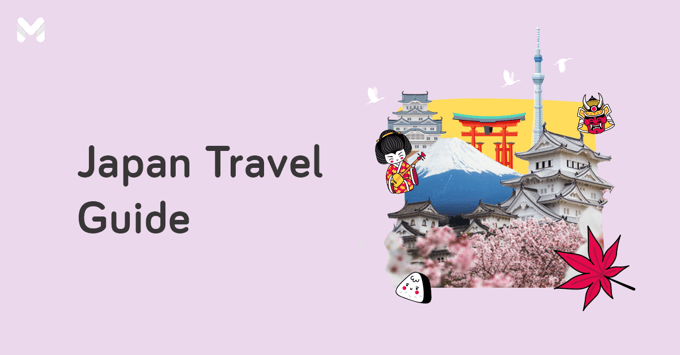Japan is a vision. Its towering skyscrapers, serene temples, ultra-modern public transport, and kawaii culture will always be novel no matter how many times you visit the country.
For the uninitiated, two words best describe the Land of the Rising Sun: sensory overload. That’s especially true when you visit big metropolitan areas, such as Tokyo and Osaka. There are just so many interesting spots to visit, dishes to try, malls to shop in, and activities to experience that the trip gets overwhelming at times.
Nevertheless, you can curb the stress with the right preparation. Here are some tried and tested Japan travel tips. We’ve also listed some recommendations on destinations and food to make the entire trip more memorable.
Before You Go: Important Things to Remember
Don’t book that 7-day Japan tour guide package just yet! Here are some essential details you need to take note of:
📌 Does Japan Require a Travel Visa?
While the Philippines does have a tourism cooperation deal with Japan, you still need a travel visa to enter the East Asian country.[1] Fortunately, the requirements are relatively easy. You won’t have to go to the embassy since applications are coursed through accredited travel agencies. Feel free to check out our comprehensive Japan visa guide.
Read more: Prepare These Requirements for Travel Abroad Before You Fly Out
📌 Japan Travel Quarantine Rules
Just like other tourism powerhouses in Asia, Japan doesn’t require a COVID-19 vaccination certificate or a negative COVID-19 test certificate anymore. This means that you can fly to this country with the regular travel requirements.
📌 Getting to and Around Japan
-2.png?width=638&height=425&name=Pics%20for%20blog%20-%20600x400%20(17)-2.png)
Many air carriers, such as Cebu Pacific, AirAsia, and Philippine Airlines, offer direct flights to Japan. Cebu Pacific, for instance, has flights to Japan’s key cities, such as Tokyo, Osaka, Nagoya, and Fukuoka.
Philippine Airlines also offers more locations on top of the key cities. These include Sapporo, Miyazaki, Iwakuni, Okinawa, and Nagasaki, among others. If you want more destination options, check AirAsia, as it hosts flights from other air carriers.
Japan’s public transportation is one of the best in the world.[2] At its heart are the trains running on extensive railroads with a total length of more than 30,600 km.
These passenger haulers are clean, efficient, and always on time. They can transport you to and from major airports, and they cover almost all towns and cities. This means that you can travel from the country’s northern region to the southern region and vice versa by just riding the train!
Complementing the trains are buses and taxis, which are always present in major cities and rural areas.
Have you booked your flights yet? The next time you buy airline tickets, consider using an air miles credit card to earn points that you can later redeem for free flights. Take a look at some of the recommended cards for booking flights and other travel must-haves:
| Credit Card | Air Miles and Travel Benefits |
|
Metrobank World Mastercard®
|
|
|
HSBC Red Mastercard
|
|
|
Security Bank Platinum Mastercard
|
|
|
|
|
BPI Signature Card
|
|
|
BPI Platinum Rewards Card
|
|
|
PNB-PAL Mabuhay Miles NOW Mastercard
|
|
|
PNB-PAL Mabuhay Miles Platinum Mastercard
|
|
🎁 Free Gift from Moneymax: ₱2,500 Cash Credits, Dolce Gusto Piccolo XS, or Xiaomi Redmi Bluetooth Soundbar
Eligible cards: Metrobank Titanium Mastercard®, Platinum Mastercard®, and World Mastercard®
Promo period: Until May 31, 2024
How do you get a Metrobank credit card welcome gift? Simple! Just apply and get approved for any eligible card through the Moneymax website.
Choose between ₱2,500 worth of cash credits via Giftaway, a Dolce Gusto Piccolo XS worth ₱5,199, or a Xiaomi Redmi Bluetooth Soundbar worth ₱2,499 as your free special gift.
This Moneymax Metrobank eGift/Dolce Gusto/Xiaomi Redmi promo runs until May 31, 2024 only. Hurry and apply now!
Per DTI Fair Trade Permit No. FTEB-191118 Series of 2024. Terms and conditions apply.
Note: Applicant must be an existing credit cardholder in good standing for at least nine months.
📌 How Much Does it Cost to Travel in Japan?
How much do you need to travel to Japan? This will depend on the following factors: the number of days you’re staying in the country, the number of attractions you want to visit, and your shopping plans.
To manage your expectations, the cost of living in Japan is quite expensive. A budget for a Japan trip of ₱2,000 to ₱4,000 a day should suffice. But keep in mind that it may get higher depending on your activities. If you’re staying for at least seven days, prepare between ₱30,000 to ₱60,000. Excluded from this budget are the round-trip flights, your accommodation, and pasalubong.
The Japanese Yen is Japan’s currency. As of this writing, ¥1 is equivalent to ₱0.39.
Read more:
- On a Budget? Travel Tips and Hacks to Try for a More Meaningful Trip
- Trip to Asia 2023: Cheapest Country to Travel to from the Philippines
✈️ Book Your Trip Now, Pay Later with #UNOnow Loan!
Fulfill your travel goals without worrying about your budget. UNO Digital Bank has got your back! You can easily apply online for an #UNOnow Loan—no collateral needed—and get extra cash for booking your trips.
Enjoy quick approval and disbursement, as well as flexible payment terms, so you can travel now and pay later. Apply via Moneymax now!
21 Best Japan Travel Tips
Creating a checklist for Japan travel? The best guide should include the following Japan travel tips, so you can avoid certain hassles and make the most of your stay.
✔️ Decide on the Best Time to Visit Japan
-1.png?width=641&height=427&name=Pics%20for%20blog%20-%20600x400%20(18)-1.png)
Truth be told, the best time to visit Japan is anytime! But it will still depend on your personal objectives. Each season gives Japan a specific kind of charm, so choosing can be quite a challenge.
Here’s a table to help you decide on Japan's best travel time:
|
Seasons
|
Pros
|
Cons
|
|---|---|---|
|
Spring (March to May)
|
|
|
|
Summer (June to August)
|
|
|
|
Autumn (September to November)
|
|
|
|
Winter (December to February)
|
|
|
✔️ Know Your Trains
One of the most important first-time Japan travel tips is to know the trains. This will help you plan your trip accordingly and maximize your stay.
More than 100 companies provide the country with rail services. Perhaps the most popular is the Japan Railways Group (JR Group), which operates about 70% of Japan’s railroad networks. It connects all the major cities of the country, from Hokkaido Island’s Sapporo in the north to Kyushu Island’s Fukuoka in the south. The remaining private railway companies have trains running through specific cities, suburban areas, and smaller towns.
You may find it difficult to tell the differences between the rail services those companies offer. To make it easy, just remember that trains in Japan are generally divided into five types:
- Shinkansen or Bullet Trains - Operated by the JR Group, shinkansen are high-speed trains that connect all major cities of Japan. They reach a top speed of 320 km/h. To put this in perspective, you can reach Kyoto from Osaka, which has a travel distance of around 50 km, within 13 to 15 minutes.
- Limited Express or Special Express Trains - These fast trains only have limited stops. They skip a lot of stations and only stop at major or popular ones.
- Express Trains - Express trains are also operated by the JR Group. Their difference from limited express trains is that they have more stops.
- Rapid Trains - Rapid trains have more stops than express trains. While slower than express trains, their fares are cheaper.
- Local Trains - These are the slowest trains since they stop at every station. They’re ideal for short-distance trips.
✔️ Get an IC Card
Using public transport is more convenient with the integrated circuit card or IC card. Just like our very own beepTM card, it’s a reloadable card that you can use to pay for train and bus fares. With it, you don’t need to buy a fare ticket every time you board a train or bus. You can also use your IC card to purchase items at vending machines, restaurants, convenience stores, and select shops.
Major cities have their own IC card. The Greater Tokyo, Niigata, and Sendai regions use Suica, Tokyo has Pasmo, while Osaka has Icoca.
You can reload your IC card at train stations and convenience stores. If you don’t want to carry your card, you can integrate it into your iPhone, Apple Watch, or Android phone. With this setup, you’ll only have to hover your device over the card reader to pay for your ride. You can also top up your virtual ticket using the Add Money feature of your device’s wallet.
✔️ Buy Your Japan Rail Pass Before Flying In
-Feb-24-2023-04-09-43-4864-AM.png?width=638&height=425&name=Pics%20for%20blog%20-%20600x400%20(6)-Feb-24-2023-04-09-43-4864-AM.png)
The Japan Rail Pass or JR Pass is a special train pass only offered to foreign tourists. It gives you unlimited rides on JR trains for seven, 14, or 21 consecutive days. It’s valid on almost all JR-operated trains, including shinkansen, limited express, express, rapid, and local trains. You can also use your JR pass to ride local JR buses and even JR ferries.
The JR pass, however, isn’t always the best option for train travel. It’s a practical choice for those traveling the whole country or if your itinerary requires a lot of bullet train rides. But you won’t be able to maximize your JR pass if you’re staying in just one city. If you’re moving from just one city to the other, just use the local or express train and pay with your IC card.
It would be wise to book your JR Pass before you fly to Japan, as it’s cheaper at ticketing partners, such as Klook and KKday.
✔️ Use Google Maps to Check Train Schedules
For outsiders, the train station maps of Japan’s biggest cities may look like elaborate spiderwebs—they’re confusing! But give it time, and you’ll get the hang of them.
If you want to navigate train stations fast, using Google Maps is obviously one of the best first-time Japan travel tips. It’ll give you specific directions on how to reach your destination—covering the train lines you need to take, the platforms where you should wait, the train’s arrival and departure schedules, and the travel time. Moreover, it offers train route options.
In case you miss your train, just refresh your Google Maps app to get new recommendations. You can’t simply ride the next train, as it follows a different route—one that may not take you to your destination.
✔️ Avoid the Rush Hour
-Dec-15-2023-07-34-41-9234-AM.png?width=641&height=427&name=Pics%20for%20blog%20-%20600x400%20(23)-Dec-15-2023-07-34-41-9234-AM.png)
If you’re traveling to Tokyo, the best way to navigate the city is by train. But there’s a trade-off—everyone is also traveling via trains, making rush hours truly hectic and unbearable.
As much as possible, avoid the rush hours, especially if you have your luggage and shopping haul in tow. The JR Yamanote Line in Tokyo, which goes full circle around the metropolis, can get really crowded between 5:00 p.m. and 7:00 p.m. Try alternative lines or the routes suggested by Google Maps.
In this regard, one of the best travel tips in Japan is to walk in case your destination is just one station away. After all, some stations are only within walking distance of each other.
✔️ Consider Renting a Car
If you have a valid International Driving Permit (IDP), you can legally drive in Japan. Use this opportunity to rent a car, especially if you’re exploring small rural communities.
Renting a car is a wise move if you’re traveling outside giant metropolises where trains may be scarce. It’s also perfect for those who want to take their trip at their own pace.
✔️ Wear the Right Footwear
One of the best Japan travel tips for foreigners is wearing the right shoes. You’ll be walking a LOT in this country, which will hurt and even injure your feet.
Find the right travel shoes with these tips:
- Get a pair of shoes with a solid arch support. This will give you stability and balance.
- Pick lightweight shoes. Chunky and heavy footwear can easily hurt your feet.
- As much as possible, get shoes with laces. Laces can keep your feet and the shoe soles together better than slip-ons and slippers.
✔️ Book a Tour if Necessary
Many experienced travelers champion DIY trips, as they offer flexibility and save a lot of money. But in some cases, guided tours make more sense.
For one, it helps you reach destinations that are not normally reached by public transportation. Another reason is that it provides convenience for groups traveling with kids and senior citizens.
Book a guided tour in Japan for comfort. Transportation is provided, and you have a tour guide who will give you an overview of your destination. Depending on the tour you’ve booked, meals may be already provided.
You can book tours via platforms like Klook and KKday
✔️ Shop at Convenience Stores
-3.png?width=642&height=428&name=Pics%20for%20blog%20-%20600x400%20(16)-3.png)
Also known as konbini, convenience stores are quintessential icons of modern-day Japan. They offer a wide array of food, drinks, and essential services, such as bills payment, ATM, and IC card reloading. The konbini is your life-saver if you want to save on food expenses since meals are cheaper here compared to fast food joints and restaurants. But don’t underestimate their products, as the quality is superb.
Some of the most popular konbinis are 7-Eleven, FamilyMart, and Lawson. If you’re playing it safe, start with their egg salad sandwiches, which have a legendary reputation among tourists. Don’t forget to try their coffee and quirkily flavored sodas.
✔️ Score Discounts at Groceries During Closing Time
Although there are many cheap restaurants in Japan, eating out is generally expensive. You can avoid putting a dent in your wallet by rushing to the local grocery store during closing time. This is because perishable items are usually discounted within this window. You can buy pre-cooked bento boxes, side dishes, bread, fruits, veggies, and even meats. Spotting these discounted items shouldn’t be difficult as they have stickers on them.
✔️ Keep Your Trash in Your Bag or Pocket
Japan is an incredibly clean country. But the irony of it all is that public garbage bins are almost non-existent. So if you have trash, just keep it in your pocket or bag. Nevertheless, you may find trash cans in public toilets, train stations, and even next to vending machines.
Among the most practical Japan travel tips is to bring a spare plastic bag where you can keep your trash. That way, you won’t have to keep your rubbish in your pocket.
✔️ Use Sightseeing Passes
Sightseeing passes can help you manage your budget since they usually bundle unlimited train rides and access to tourist attractions. Take the Osaka Amazing Pass for example. It entitles you to unlimited rides on Osaka Metro trains and buses and free entrance to more than 40 sightseeing spots.
A two-day Osaka Amazing Pass costs ¥3,600 or around ₱1,400. This is definitely a steal if you’ll be riding a lot of Osaka Metro trains, knowing that a single journey costs ¥180 to ¥380 or around ₱70 to ₱150.
✔️ Buy Attraction Tickets and Restaurant Slots in Advance
Japan has zillions of tourists. This makes access to certain destinations and attractions quite a challenge.
One of the most practical Japan travel tips is to book your attraction tickets in advance. Do it online for convenience. That way, you won’t have to line up at the ticketing booth at your destination.
While you’re at it, reserve your slot at popular restaurants. Depending on the volume of diners, omakase shops and Michelin guide restaurants may not accept walk-in customers.
✔️ Always Bring Cash
-1.png?width=639&height=426&name=Pics%20for%20blog%20-%20600x400%20(19)-1.png)
Despite Japan’s modernity, the country is still a heavily cash-based society. While credit card payments are getting more popular, a lot of shops may not have the facility to accept contactless payments. To avoid the hassle, always bring cash, especially if you’re shopping at rural markets or dining at restaurants.
✔️ Rent Your Wi-Fi Broadband Online
Because Japan is very big on tech, you might expect that free Wi-Fi is available everywhere. It is not! You may choose to buy a data SIM card, but if you’re traveling with a group, a pocket Wi-Fi is a cheaper and more practical choice.
Both SIM cards and pocket Wi-Fi devices are available at online booking companies, such as Klook and KKday. After booking in advance, you can pick up the SIM card or pocket Wi-Fi at the airport or at a designated redemption center. You also have the option to have it delivered to your hotel.
✔️ Save Big on Shopping at Tax-Free Shops
-3.png?width=638&height=425&name=Pics%20for%20blog%20-%20600x400%20(15)-3.png)
One of the main objectives of Japan travel recommendations is to help you maximize your budget while having a good time. If shopping is your passion, you’ll be pleased to hear that tax-free shopping is a thing in Japan.
Tax exemption applies to general goods and consumables. General goods include appliances, shoes, bags, and clothes, among others. Consumables, on the other hand, are food, liquor, fruits, medicines, and cosmetics. To qualify, you must spend at least ¥5,000 or around ₱2,000. The cashier will also require your passport, so make sure you have it when you decide to go shopping.
It’s easy to spot tax-free shops since they have very large signs. Perhaps the most popular is Don Quijote. If you shop here, take note that you need to pay at the designated tax-free counter.
🎁 Free Gift from Moneymax: Giftaway Cash Credits, JBL Flip 6, or JBL Wave Beam
Eligible cards: HSBC Red Mastercard, Gold Visa Cash Back, and Platinum Visa Rebate
Promo period: Until June 30, 2024
Not an HSBC credit cardholder yet? Apply for an HSBC card through Moneymax during the promo period (and get approved subsequently) to receive an exciting welcome gift! Choose from free Giftaway cash credits worth ₱3,000, a JBL Flip 6 worth ₱7,499, or a JBL Wave Beam worth ₱3,799.
This Moneymax HSBC Giftaway/JBL promo runs until June 30, 2024 only. So hurry and apply now!
Per DTI Fair Trade Permit No. FTEB-192974 Series of 2024. Terms and conditions apply.
✔️ Go on a Gastronomic Adventure
-Dec-15-2023-07-42-36-4891-AM.png?width=641&height=427&name=Pics%20for%20blog%20-%20600x400%20(24)-Dec-15-2023-07-42-36-4891-AM.png)
A list of Japan travel tips won’t be complete without fantastic food recommendations. The Land of the Rising Sun is also the land of delicious cuisines, so you might as well go on a food-venture. Here are our recommendations besides the likes of sushi, ramen, and takoyaki.
- Kushikatsu - Otherwise known as kushiage, kushikatsu is meat or vegetable covered in batter, deep-fried, and then skewered. These fried goodies on sticks go well with a special sweet sauce.
- Unagi - Unagi is a freshwater eel that has been broiled and then grilled while being coated with sweet soy sauce. The portioned eel is usually served over hot rice.
- Oden - Oden is a one-pot dish of fish cakes, egg, daikon (radish), and tofu simmered in dashi broth. While available all year round, it’s most popular during winter.
- Okonomiyaki - It’s a savory pancake cooked on a teppanyaki grill with a variety of fillings and ingredients, such as meat, seafood, cabbage, and even yakisoba. The pancake is then slathered with a sweet sauce, Japanese mayo, bonito flakes, and seaweed flakes.
- Curry - Japanese curry is a rice meal served with curry sauce, vegetables, and your choice of meat. You can choose from beef, pork, and chicken.
- Mochi - This is a popular dessert made of glutinous rice, usually filled with sweet red bean paste, custard, and even ice cream. Its consistency will remind you of our very own bilo-bilo.
- Dorayaki - Channel your inner Doraemon with this classic dessert made of two small pancakes held together by sweet red bean paste. Technically, it’s a pancake sandwich.
✔️ Practice Basic Japanese Words
The majority of the Japanese population speaks Nihongo or the Japanese language. People in cities, like Tokyo, Osaka, and Kyoto may understand some English. Despite that, they may have a hard time speaking the language. As a compromise, there will be a lot of pointing and gesturing.
You can use translation apps, such as Google Translate and Papago, which do photo, voice, and text translation. Nevertheless, some basic Japanese may help you warm up to your landlord or the waitstaff at the restaurant. Here are some useful Japanese phrases:
- Konnichiwa – Hello
- Ohayo gozaimas or Ohayo – Good morning
- Konbanwa – Good evening
- Arigato gozaimas – Thank you
- Doitashimashte – You’re welcome
- Sumimasen – Excuse me
- Wakarimasen – I don’t understand
- Hai – Yes
- Iiye (pronounced as “i-ye”) – No
- Hajimemashte – Nice to meet you
- (Your name) desu – I am (your name)
- Itadakimasu – Enjoy the meal (usually said before eating as a sign of appreciation)
- Kanpai! – Cheers!
- Oishi – Delicious
- Tadaima – I just got home
- Sayonara – Goodbye
- O genki desu ka – How are you?
- Genki desu – I’m fine
✔️ Mind Your Etiquette
-Feb-24-2023-04-31-10-0828-AM.png?width=639&height=426&name=Pics%20for%20blog%20-%20600x400%20(11)-Feb-24-2023-04-31-10-0828-AM.png)
A major Japan travel tip is being acquainted with the country’s culture. While Japanese people don’t expect you to know all their rules of etiquette, make some effort to show that you care and respect them. Keep the following things in mind:
- Always take off your shoes when the establishment requires it. This rule applies to houses, hotels, restaurants, museums, temples—virtually everywhere!
- Express your thanks or apology by bowing.
- Always be on time. Filipino time is not a thing in Japan. Everything and everyone is always punctual.
- Use your chopsticks correctly. Never play with them or use them to point at people or things. Never ever stick them into your rice, as they’ll resemble funeral incense sticks.
- Do not smoke on the street. While Japan is quite lenient with cigarettes (you can smoke inside restaurants, and some trains even have smoking rooms), smoking on the street is frowned upon.
- Always clean up after yourself. Fast food restaurants and some food courts require you to clean your table, put the trash in the bin, and return the tray to where you got it.
- Be quiet inside the train. You can still have conversations, but keep your voice low. The same rule applies to other public spaces.
🎁 Free Gift from Moneymax: ₱2,500 eGift, JBL Bluetooth Speaker, or JBL Wireless Earbuds
Eligible cards: Select Security Bank credit cards:
Promo period: Until May 31, 2024
Want a credit card from Security Bank? You're in for a treat if you apply and get approved for an eligible card through Moneymax and meet the minimum spend requirement. Pick your free Security Bank welcome gift: a ₱2,500 Giftaway eGift voucher, a JBL Horizon 2 Bluetooth Clock Radio Speaker worth ₱5,354, or JBL Wave Beam True Wireless Earbuds worth ₱3,799.
This Moneymax Security Bank Giftaway/JBL Horizon 2/JBL Wave Beam credit card promo runs until May 31, 2024 only. Apply now!
Per DTI Fair Trade Permit No. FTEB-191158 Series of 2024. Terms and conditions apply.
✔️ Make Your Itinerary As Light As Possible
For a tourist, every corner of Japan is beautiful. You may want to cram countless destinations into your itinerary, but we highly advise that you fight the urge to do that. When you have a hectic travel plan, going to the next spot may feel like a race. You’ll also get so tired from all the walking that you’ll find it hard to appreciate your surroundings.
One of the most sensible Japan travel tips is to choose your destinations wisely. Give your schedule breathing space, so you’ll have a chance to rest and soak in the beauty around you.
If you’re drafting your itinerary, prioritize the most popular spots, such as the following:
📍 Shinjuku
-Feb-24-2023-04-23-06-6051-AM.png?width=640&height=426&name=Pics%20for%20blog%20-%20600x400%20(8)-Feb-24-2023-04-23-06-6051-AM.png)
- Location: Shinjuku District, Tokyo
- How to get there: From Narita Airport, take the Narita Express train. From Haneda Airport, take a train on Keikyu Line and transfer to JR Yamanote Line at Shinagawa Station; then, alight at Shinjuku Station. A more convenient option is the Limousine Bus that stops in Shinjuku.
Every Japan travel guide on Tokyo includes the Shinjuku district for many good reasons. For one, it’s a massive shopping haven. Second, its illumination at night is a sight to behold; the big neon lights are what define the Tokyo that you see in movies, TV shows, and documentaries.
In the morning, you can take a serene stroll in Shinjuku Gyoen, a public garden filled with cherry trees. At night, get your yakitori fix at Memory Lane or Piss Alley, a small alleyway lined with restaurants, bars, and shops. Alternatively, you can visit Kabukicho, Tokyo’s red light district where you can spot the gigantic Godzilla head statue.
While you’re at it, visit the neighboring Shibuya district, which is a popular spot among younger Japanese. Witness or get lost in the madness that is the Shibuya Crossing, one of the most iconic intersections in the world.[3]
📍 Yokohama
-Dec-15-2023-07-50-43-6726-AM.png?width=641&height=427&name=Pics%20for%20blog%20-%20600x400%20(25)-Dec-15-2023-07-50-43-6726-AM.png)
- Location: Kanagawa Prefecture, South of Tokyo
- How to get there: Ride a JR train bound for Yokohama at Shinjuku Station or Tokyo Station.
Yokohama, Japan’s second-largest city, is just an hour away from Tokyo via train, making it a good option for a day tour.
The city has many attractions you and your family can enjoy. First on your list should be Minato Mirai, which is a seaside district that features high-rise buildings, hotels, shopping malls, and entertainment areas. Ride the ferry at night to get a glimpse of this neighborhood’s sparkling skyline.
Still in Minato Mirai, the Cup Noodles Museum lets you explore the history of cup noodles through interactive exhibits. You can even make your instant noodles for a fee.
Gundam Factory Yokohama, on the other hand, features an 18-meter-tall Gundam that moves, fascinating both mecha aficionados and tourists alike.
📍 Lake Kawaguchiko
-1.png?width=638&height=425&name=Pics%20for%20blog%20-%20600x400%20(20)-1.png)
- Location: Fujikawaguchiko, Southern Yamanashi Prefecture
- How to get there: Take a train at JR Shinjuku Station on the JR Chuo Line and alight at JR Otsuki Station. From there, switch to Fuji Kyuko Line and alight at Kawaguchiko Station. You may also take a direct bus at the Shinjuku Bus Terminal.
If you’re traveling to Japan in spring, you shouldn’t miss Lake Kawaguchiko. Here, you can enjoy the majestic views of Mount Fuji. Time your visit early in the morning or late in the afternoon, so you’ll see the magnificent mountain without the clouds.
There are also a lot of interesting spots and activities in the Kawaguchiko area. You can visit various museums, go on a boat tour, or relax in hot springs.
Lake Kawaguchiko makes a good day trip from Tokyo. Via train, the trip takes approximately two to three hours. If you’re riding the bus, you can reach this spot in less than two hours.
📍 Namba
-Feb-24-2023-04-25-15-7826-AM.png?width=641&height=427&name=Pics%20for%20blog%20-%20600x400%20(9)-Feb-24-2023-04-25-15-7826-AM.png)
- Location: Namba District, Osaka
- How to get there: From Kansai Airport, ride a Nankai Railway train bound for Nankai Namba Station. You can also ride an Osaka Metro train on the Midosuji Line or a JR train all bound for their respective stations in Namba.
Namba is a fixture in every Japan travel guide on Osaka because of its electric spiritedness, especially at night. While there are many interesting spots in this neighborhood, Dotonbori is the first place you may want to visit.
Located along the Dontonbori canal, Dotonbori gets extravagant at night because of its loud neon lights and big colorful signs. Take that mandatory picture with the Glico Man or stroll through the branching alleyways offering a little bit of everything.
Love anything manga or anime? Pay Nipponbashi Den Den Town a visit. This shopping street is lined with video arcades, maid cafés, and specialty shops.
More shopping awaits at Namba Walk. What makes this sprawling shopping center unique is that it’s located underground.
📍 Arashiyama
-1.png?width=642&height=428&name=Pics%20for%20blog%20-%20600x400%20(21)-1.png)
- Location: Arashiyama District, Kyoto
- How to get there: From Osaka Station, take a JR train bound for Kyoto Station. Once at Kyoto Station, ride the JR Sagano train bound for JR Arashiyama Station.
Unlike Osaka, Kyoto is calmer and closer to nature. If you want more of the latter, the Arashiyama district is the place to be.
Start your journey by going on a two-hour boat cruise down the Hozu River. As the currents take you away, marvel at the surrounding mountains, which are a spectacle during spring or autumn.
After the river cruise, take a leisurely stroll at the Sagano Bamboo Forest, otherwise known as the Arashiyama Bamboo Grove. Not far from this spot is the Tenryuji Temple where you can unwind while admiring its many beautiful gardens.
📍 Higashiyama
-Dec-15-2023-07-56-34-3164-AM.png?width=641&height=427&name=Pics%20for%20blog%20-%20600x400%20(26)-Dec-15-2023-07-56-34-3164-AM.png)
- Location: Higashiyama District, Kyoto
- How to get there: From JR Osaka Station, take a train on the JR Kyoto Line bound for Kyoto Station. From Kyoto Station, ride Bus Number 206 to reach your destination within the district.
Part of this long list of Japan travel tips is visiting historical and heritage sites that give you a glimpse of the country’s past. In this regard, Kyoto’s Higashiyama District is the place to be.
Various temples are located here, such as Kiyomizudera Temple, Kodaiji Temple, and Yasaka Pagoda. If you’re visiting Kiyomizudera Temple, you might as well walk through Ninenzaka and Sannenzaka, which are old streets lined with traditional buildings. Many of these buildings are actually shops selling food and souvenirs.
You may also visit the nearby Gion District to spot geisha and explore more shops.
📍 Rokko-san
- Location: Kobe, Hyogo Prefecture
- How to get there: From Osaka, take a train on the Hanshin Main Line bound for Mikage Station. From Mikage Station, ride Bus Number 16, which will take you to the base of the Rokko Cable Car Station. Ride the cable car to reach the mountain.
Kobe is a laid-back city, not as crowded as Osaka or Kyoto. If you’re staying in Osaka, you can go on a day tour in this city since it’s just about a one-hour train ride away.
Kobe may be famed for its beef and scenic port, but you shouldn’t sleep on Mount Rokko or Rokko-san. From the top of this mountain, you’ll be treated to an uninterrupted view of Kobe and Osaka.
You can also visit various hot springs, botanical gardens, and restaurants here. Time your visit late in the afternoon to witness the sunset and the city lights.
📍 Nara
-Feb-24-2023-04-27-12-0857-AM.png?width=638&height=425&name=Pics%20for%20blog%20-%20600x400%20(10)-Feb-24-2023-04-27-12-0857-AM.png)
- Location: Nara, Nara Prefecture
- How to get there: From Osaka, ride a train on the Kintetsu Line bound for Kintetsu Nara Station.
Nara is another quick and easy day tour from Osaka. The best thing about your tour here is that the most popular tourist attractions are located close to each other.
Go on a temple run by visiting Todaiji, a large temple that houses a giant Buddha statue; Horyuji, the world’s oldest wooden building; and Kasuga Taisha, a Shinto shrine famous for its countless lanterns that are only lit twice a year. Close by is Nara Park, home to more than a thousand deer (although they are present pretty much everywhere).
After a day of visiting temples and feeding deer, take some respite on the slope of Mount Wakakusa located behind Nara Park. From this spot, you’ll get a good view of Nara City.
📍 Nagoya
-Dec-15-2023-08-05-11-6715-AM.png?width=641&height=427&name=Pics%20for%20blog%20-%20600x400%20(27)-Dec-15-2023-08-05-11-6715-AM.png)
- Location: Aichi Prefecture, Central Japan
- How to get there: Book a flight from Manila to Chubu Centrair International Airport. If you're coming from Tokyo, take the Shinkansen at Tokyo Station bound for Nagoya Station.
Nagoya, Japan’s third-largest city, is a must-visit if you want an urban sprawl that is not as congested and crowded as Tokyo. It’s laidback and has access to several interesting day tours.
If you’re just staying in Nagoya, popular places to visit include the Nagoya Castle, Atsuta Shrine, and Osu Kannon, among others. However, many seasoned travelers recommend visiting spots outside the city. For instance, you can tackle both Takayama and Shirakawa-go in one day, provided that you’ve booked a guided tour.
Takayama, which is part of Gifu Prefecture, will remind you of Kyoto, albeit less crowded. Shirakawa-go, also part of the same prefecture, is a traditional mountain village hailed as one of Japan’s UNESCO World Heritage Sites. Here, you’ll find traditional houses scattered across greenfields and surrounded by towering mountains.
Nabana no Sato Flower Park, an hour away from Nagoya, is also worth visiting. Part of Nagashima Resort, this flower village has fields and greenhouses keeping colorful blooms. At night, the flower park transforms into a visual treat with a stunning light display. More than five million LED lights illuminate the fields, creating interesting images.
📍 Fukuoka
-Dec-15-2023-08-09-14-5045-AM.png?width=641&height=427&name=Pics%20for%20blog%20-%20600x400%20(28)-Dec-15-2023-08-09-14-5045-AM.png)
- Location: Fukuoka Prefecture, Southern Japan
- How to get there: Book a flight from Manila to Fukuoka Airport.
While Fukuoka City is one of the biggest urban areas in Japan, it remains laidback compared to other popular destinations, such as Tokyo and Osaka. Located on Kyushu Island, Fukuoka has a wealth of attractions perfect for foodies and nature lovers.
Popular destinations include Kushida Shrine, one of Fukuoka’s oldest shrines; Nanzoin Temple, which features a massive statue of a reclining Buddha; and Nokonoshima Island Flower Park, which features a sprawling field of seasonal blooms.
If you’re into onsens or hot springs, Yufuin and Beppu make exciting side trips.
Read more:
- It’s a Taiwan-derful Journey: How to Get a Taiwan Visa in the Philippines
- To K-Drama Land: South Korea Travel Guide and Sample Itinerary
Final Thoughts
Japan is definitely one of the most interesting, photogenic, and culturally rich countries in the world. It has everything and more. While its cities boast big, brash lights, its countryside offers a calm atmosphere. Its cuisine will hook you. And its people will welcome you with open arms.
For newbies, Japan can be quite overwhelming—navigating train stations is difficult at first, there’s a language barrier, and there are many etiquette rules to remember. But all those should be trivial challenges, especially now that you have a helpful list of Japan travel tips.
Sources:







_1200x350.png?width=1200&height=350&name=Travel_Insurance_Generic_(Oct_2023)_1200x350.png)








-3.png?width=734&height=214&name=image%20(5)-3.png)
_1200x350.png?width=1109&height=324&name=UNOBank_Loan_-_Travel_(Sep_2023)_1200x350.png)
-May-16-2024-09-29-10-4336-AM.png?width=734&height=214&name=image%20(1)-May-16-2024-09-29-10-4336-AM.png)
-Apr-16-2024-01-32-04-6385-AM.png?width=734&height=214&name=image%20(1)-Apr-16-2024-01-32-04-6385-AM.png)



